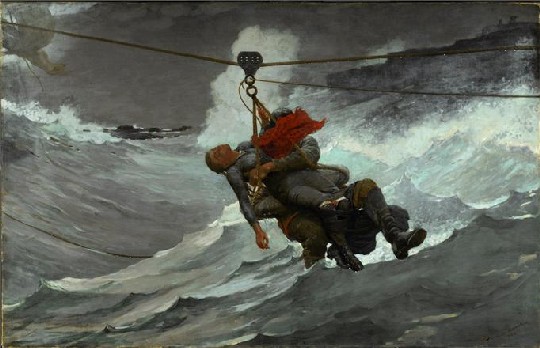Shipwreck! Winslow Homer and “The Life Line” exhibit opens Sept. 22–Dec. 16, 2012
While living in a tiny fishing village in England in 1881-82, the American artist Winslow Homer was profoundly moved by the sight of a shipwreck that would focus his imagination on the power and peril of the sea. His art took on a new seriousness and drama, demonstrated in a major painting made soon after his return to the United States: The Life Line (1884),one of his greatest popular and critical successes. A masterpiece owned by the Philadelphia Museum of Art for almost 90 years, The Life Line is the centerpiece of an exhibition about the making and meaning of an iconic American image of rescue at sea. Celebrating modern heroism and the thrill of unexpected intimacy between strangers thrown together by disaster, Shipwreck! Winslow Homer and the Life Line contains works by Homer complemented by a range of precedents in the shipwreck and rescue genre including paintings, watercolors, etchings, engravings, sketches and ceramics ranging in date from the mid-17th to the early 20th centuries. The Philadelphia Museum of Art will be the only venue for this important exhibition, which includes fragile and rarely seen watercolors, prints, and drawings.
“The Museum contains one of this nation’s greatest collections of American art and many of our finest exhibitions are inspired by it,” notes Timothy Rub, The George D. Widener Director and Chief Executive Officer. “We are delighted to focus on Homer’s The Life Line in this important exhibition, as it places a major artistic milestone in an illuminating context within the traditions of marine painting and American art and history.”
The exhibition explores the related themes of the exhilaration of ocean travel, disaster on the high seas, and romantic rescue, while examining the creative contributions of one of this country’s greatest artists to the rich tradition of marine painting. The opening gallery introduces the importance of ocean travel to the Eastern seaboard of the United States and its significance to Boston-born Homer, and includes the watercolor Clear Sailing (c. 1880; Philadelphia Museum of Art). Typical of Homer’s lighthearted work from this period, the painting shows children watching white-sailed boats on a calm and sun-drenched harbor. The next section takes on a darker tone, surveying the theme of shipwreck during the first great age of marine painting from the 17th through the 19th centuries. The aftermath of a shipwreck for those waiting onshore follows, with works based on Homer’s experience in the English village of Cullercoats, on the North Sea in 1881–2, where he witnessed the wreck of the Iron Crown. Other sections look at the theme of the romantic rescue of the helpless damsel, while “Heroes of the Coastline: The Rise of the Unites States Life Saving Service” examines the real life historical context of these rescue scenes. ”Heroes of the Coastline” also tells the story of the spectacularly successful reform of the shoddy American coastal defenses, beginning with the establishment of the United States Life Saving Service in 1871, followed by the integration of new technology and the employment of trained personnel.
Against this backdrop of tradition and recent innovation, Homer created a painting of startling modernity and old-fashioned romance. A full section of the exhibition is dedicated to the making of The Life Line, including preparatory drawings and etchings that suggest changes the artist made before arriving at the final image. These alterations, seen in revisions visible on the surface of the painting and in recent X-radiographs and infrared photographs, demonstrate Homer’s wish to focus the composition on the figure of the woman by obscuring the visage of his hero and tempering the erotic narrative of intertwined figures to suit the buttoned-up morals of the Victorian period. A section containing a small group of prints and paintings made by Homer after 1884 introduces his late marine paintings, with their themes of anxiety, struggle, and stoicism in the face of nature. Human narratives receded as more abstract treatments of elemental conflict—land, sea, and sky—came to dominate the last two decades of the artist’s career, represented by paintings such as Winter Coast, 1890 (Philadelphia Museum of Art), a study in the eternal battle of majestic natural forces.
When The Life Line was first exhibited at the National Academy of Design in New York in 1884 it became an instant sensation. Demonstrating a recent innovation in life saving technology, the breeches buoy, Homer’s painting is at once realistic and romantic, demure and suggestive. The drama of the roiling seas and realism of the breeches buoy is softened by the form of a voluptuous woman, her soaked dress clinging to her curves, being ferried to safety by an anonymous rescuer whose face is obscured by the woman’s red scarf blowing in the gale.
“Homer was at the peak of his powers when he painted The Life Line, which has never before been the subject of intensive study. It was one of the triumphs of his career, and it has remained one of his best-known paintings. This exhibition will explore how The Life Line was made, how it was understood in its own day, and why it has become such an icon of American art,” said Kathleen Foster, the Robert L. McNeil, Jr. Curator of American Art. “By placing The Life Line in the context of Homer’s work and alongside popular images of rescue at sea published by the likes of Currier & Ives, we can see how Homer drew from both old and new sources to create a strikingly modern image.”
About the catalogue: The Philadelphia Museum of Art, in association with Yale University Press, will publish a 104-page catalogue with 110 color plates and five black and white illustrations. Written by curator Kathleen Foster, Shipwreck! combines a close analysis of Homer’s masterpiece with an engaging look at historical images of disaster and rescue.It will be available in the Museum Store in paperback ($20) beginning September. It also can be purchased by calling 1-800-329-4856, or online at philamuseum.org. ISBN: 978-0-87633-238-2.
About the artist: A painter, illustrator, and etcher, Winslow Homer (1836-1910), is considered to be the greatest pictorial poet of outdoor life in American history. Dedicated to subjects based on the national experience, from Civil War to rural life and the native landscape, Homer was an artist of power and individuality whose images rise beyond realism to engage with the larger relationship of man to nature.
The exhibition is made possible by The Mr. and Mrs. Raymond J. Horowitz Foundation for the Arts. Additional support is provided in part by the Center for American Art at the Philadelphia Museum of Art. Funding for the catalogue publication is generously provided by the Davenport Family Foundation and the Wyeth Foundation for American Art.
The Philadelphia Museum of Art is among the largest museums in the United States, with a collection of more than 227,000 works of art and more than 200 galleries presenting painting, sculpture, works on paper, photography, decorative arts, textiles, and architectural settings from Asia, Europe, Latin America, and the United States. Its facilities include its landmark Main Building on the Benjamin Franklin Parkway, the Perelman Building, located nearby on Pennsylvania Avenue, the Rodin Museum on the 2200 block of the Benjamin Franklin Parkway, and two 18th-century houses in Fairmount Park, Mount Pleasant and Cedar Grove. The Museum offers a wide variety of activities for public audiences, including special exhibitions, programs for children and families, lectures, concerts and films.
For additional information, contact the Marketing and Communications Department of the Philadelphia Museum of Art at (215) 684-7860. The Philadelphia Museum of Art is located on the Benjamin Franklin Parkway at 26th Street. For general information, call (215) 763-8100, or visit the Museum's website at www.philamuseum.org.



Comments